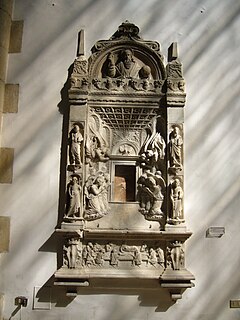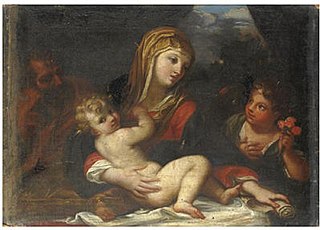Related Research Articles

Antonello da Messina, properly Antonello di Giovanni di Antonio, but also called Antonello degli Antoni and Anglicized as Anthony of Messina, was a Sicilian painter from Messina, active during the Early Italian Renaissance. His work shows strong influences from Early Netherlandish painting, although there is no documentary evidence that he ever travelled beyond Italy. Giorgio Vasari credited him with the introduction of oil painting into Italy, although this is now disputed. Unusually for a south Italian artist of the Renaissance, his work proved influential on painters in northern Italy, especially in Venice.

Antonello Gagini (1478–1536) was an Italian sculptor of the Renaissance, mainly active in Sicily and Calabria.

Domenico Gagini was a Swiss-Italian sculptor who was active in Northern as well as Southern Italy.

Giacinto Calandrucci was an Italian painter of the Baroque period.

Pietro Novelli was an Italian painter of the Baroque period, active mainly in Palermo. Also known as il Monrealese or Pietro "Malta" Novelli to distinguish him from his father, Pietro Antonio Novelli I. He was also nicknamed by contemporaries as the Raphael of Sicily.

Mariano Riccio was an Italian painter of the Renaissance period.
Antonello Riccio was an Italian painter of the Renaissance period.

Antonio Barbalonga or Barbalunga, also called Antonio Alberti, was an Italian painter of the Baroque period.

Filippo Tancredi (1655–1722) was an Italian painter.
Giacomo Gagini was an Italian sculptor of the Gagini family.

Girolamo Alibrandi (1470-1524), was an Italian painter, born and active in Sicily, called the Raphael of Messina.
Vincenzo degli Azani was an Italian painter, active mainly in his native Palermo, except for a spell in Rome, where he came under the influence of Raphael. He is also known as Vincenzo da Pavia, Vincenzo Aniemolo, Vincenzo degli Azani da Pavia, Il Romano and Vincenzo Romano.

Pierre Coustain was a painter and sculptor at the Court of Philip the Good. His name occurs in the records of the brotherhood of St. Luke at Bruges in the year 1450 as Painter Royal.

Friedrich August Elsasser (1810-1845), a painter of landscapes and architectural views, was born at Berlin and studied at the Academy of that city under Blechen, whose influence on art was at that time very great. In 1831 he went to Italy, and in 1834 and 1835 he visited Sicily.

Giuseppe Errante was an Italian painter.

Riccardo Quartararo was an Italian painter of the Renaissance period, active in Sicily and Naples.
The Gagini or Gaggini were a family of architects and sculptors, originally from Bissone on Lake Lugano. This family founded Sicily's Gagini school, which flourished until the mid-1600s.

The Church of Saint Francis of Assisi is a Gothic-style, Roman Catholic church of Palermo. It is located near a major and ancient street of the city, via Cassaro, in the quarter of the Kalsa, within the historic centre of Palermo. The building represents the main Conventual Franciscan church of Sicily, and has the title of minor basilica.
Antonio Crescenzio was an Italian painter, active in Palermo, Sicily.
Antonello is an Italian masculine given name as well as a nickname and surname that is a variant of Antonio. Notable people with this name include the following:
References
 This article incorporates text from a publication now in the public domain : Bryan, Michael (1886). "Crescenzio, Antonello". In Graves, Robert Edmund (ed.). Bryan's Dictionary of Painters and Engravers (A–K). Vol. I (3rd ed.). London: George Bell & Sons.
This article incorporates text from a publication now in the public domain : Bryan, Michael (1886). "Crescenzio, Antonello". In Graves, Robert Edmund (ed.). Bryan's Dictionary of Painters and Engravers (A–K). Vol. I (3rd ed.). London: George Bell & Sons.